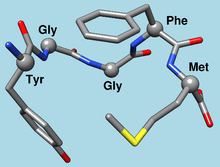Symbol PENK HUGO 8831 RefSeq NM_006211 | Entrez 5179 OMIM 131330 UniProt P01210 | |
 | ||
An enkephalin (occasionally spelt encephalin) is a pentapeptide involved in regulating nociception in the body. The enkephalins are termed endogenous ligands, as they are internally derived and bind to the body's opioid receptors. Discovered in 1975, two forms of enkephalin were discovered, one containing leucine ("leu"), and the other containing methionine ("met"). Both are products of the proenkephalin gene.
Contents
What are endorphins and enkephalins
Endogenous opioid peptides
There are three well-characterized families of opioid peptides produced by the body: enkephalins, endorphins, and dynorphins. The met-enkephalin peptide sequence is coded for by the enkephalin gene; the leu-enkephalin peptide sequence is coded for by both the enkephalin gene and the dynorphin gene. The proopiomelanocortin gene (POMC) also contains the met-enkephalin sequence on the N-terminus of beta-endorphin, but the endorphin peptide is not processed into enkephalin.
Enkephalin receptor
The receptors for enkephalin are the delta opioid receptors and mu opioid receptors. Opioid receptors are a group of G-protein-coupled receptors, with other opioids as ligands as well. The other endogenous opioids are dynorphins (that bind to kappa receptors), endorphins (mu receptors), endomorphins, and nociceptin/orphanin FQ. The opioid receptors are ~40% identical to somatostatin receptors (SSTRs).
